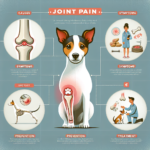Havanese Joint Pain: Causes, Symptoms, Prevention, and Treatment

Introduction
The Havanese, a charming and affectionate breed, is known for its lively personality and silky, flowing coat. Originating from Cuba, the Havanese has a rich history as a beloved companion dog, often referred to as the “Velcro dog” due to its tendency to stick close to its owners. This small but sturdy breed typically weighs between 7 to 13 pounds and stands about 8.5 to 11.5 inches tall. With a lifespan of 14 to 16 years, the Havanese is generally a healthy breed, but like all dogs, it is prone to certain health issues.
Among the common health concerns for the Havanese are eye disorders, heart conditions, and joint problems. Joint pain, in particular, can significantly impact the quality of life for these dogs, making it a critical area of focus for owners. Ensuring good joint health is essential for maintaining the Havanese’s mobility and overall well-being.
Breed-Specific Joint Pain Risks
Genetic Predisposition
The Havanese breed has a genetic predisposition to several joint-related issues, including hip dysplasia, patellar luxation, and arthritis. Hip dysplasia occurs when the hip joint does not fit properly into the hip socket, leading to pain and mobility issues. Patellar luxation, another common problem, involves the dislocation of the kneecap, which can cause intermittent lameness and discomfort. Arthritis, a degenerative joint disease, can develop as the dog ages, leading to chronic pain and stiffness.
Age-Related Risks
As Havanese dogs age, the risk of developing joint pain increases. While younger dogs may show few signs of joint issues, older Havanese are more likely to experience arthritis and other degenerative joint conditions. Owners should be particularly vigilant as their dogs approach middle age, typically around 6 to 8 years old, and continue to monitor for signs of joint pain as they enter their senior years.
Activity Level and Joint Stress
The Havanese is an active and playful breed, often engaging in activities such as running, jumping, and playing fetch. While regular exercise is essential for maintaining overall health, excessive or high-impact activities can place additional stress on the joints, potentially exacerbating existing issues or leading to new problems. Owners should balance their Havanese’s activity level to ensure it remains healthy without overburdening its joints.
Common Symptoms of Joint Pain in Havanese
General Symptoms
Owners should be aware of several common symptoms of joint pain in Havanese dogs, including:
- Limping or favoring one leg
- Stiffness, especially after rest or sleep
- Reluctance to jump, run, or climb stairs
- Decreased activity or playfulness
- Swelling around the joints
- Whining or showing signs of discomfort when touched
Breed-Specific Symptoms
In addition to the general symptoms, Havanese dogs may exhibit breed-specific signs of joint pain. Due to their small size and build, they might show subtle changes in their gait or posture. Owners should pay close attention to any changes in their dog’s movement or behavior, as these can be early indicators of joint issues.
When to Consult a Vet
If a Havanese dog displays any of the symptoms mentioned above, it is crucial to consult a veterinarian promptly. Early diagnosis and intervention can help manage joint pain more effectively and improve the dog’s quality of life. Regular veterinary check-ups are also essential for monitoring joint health and catching any issues early.
Preventive Measures for Joint Health
Exercise Recommendations
Maintaining an appropriate exercise routine is vital for the Havanese’s joint health. Low-impact activities such as walking, swimming, and gentle play are ideal for this breed. Owners should avoid high-impact exercises like excessive running or jumping, which can strain the joints. Consistent, moderate exercise helps keep the joints flexible and muscles strong, supporting overall joint health.
Dietary Suggestions
A balanced diet rich in essential nutrients is crucial for maintaining joint health in Havanese dogs. Foods containing glucosamine, chondroitin, and omega-3 fatty acids can support joint function and reduce inflammation. Owners may also consider supplements specifically designed for joint health, but it is essential to consult a veterinarian before adding any new supplements to the dog’s diet.
Weight Management
Maintaining a healthy weight is one of the most effective ways to reduce joint stress in Havanese dogs. Excess weight places additional pressure on the joints, exacerbating pain and discomfort. Owners should monitor their dog’s weight closely and provide a balanced diet to prevent obesity. Regular exercise also plays a crucial role in weight management.
Early Screening and Monitoring
Early screening and regular monitoring are essential for catching joint issues before they become severe. Veterinarians can perform specific tests to assess joint health, such as X-rays or physical examinations. Early detection allows for timely intervention, which can significantly improve the dog’s quality of life.
Treatment Options for Joint Pain
Non-Surgical Treatments
Several non-surgical treatment options are available for managing joint pain in Havanese dogs:
- Medications: Anti-inflammatory drugs and pain relievers can help manage pain and reduce inflammation.
- Physical Therapy: Exercises and therapies designed to improve joint function and reduce pain.
- Lifestyle Adjustments: Modifying the dog’s activity level and environment to reduce joint stress.
Surgical Options
In severe cases, surgical intervention may be necessary to alleviate joint pain. Common surgical options include:
- Hip Replacement: Replacing the damaged hip joint with an artificial one.
- Arthroscopy: A minimally invasive procedure to clean out the joint and remove damaged tissue.
- Joint Fusion: Fusing the joint to reduce pain and improve stability.
Surgical options should be considered carefully and discussed with a veterinarian to determine the best course of action for the individual dog.
Alternative Therapies
Alternative therapies can also be beneficial for managing joint pain in Havanese dogs. Some options include:
- Acupuncture: Using needles to stimulate specific points on the body to reduce pain and inflammation.
- Hydrotherapy: Water-based exercises that provide low-impact resistance to improve joint function.
- Massage: Gentle massage techniques to relieve muscle tension and improve circulation.
These therapies can be used in conjunction with traditional treatments to provide a comprehensive approach to managing joint pain.
Lifestyle and Management Tips
Daily Care Routine
A consistent daily care routine can help manage and alleviate joint pain in Havanese dogs. This routine might include:
- Regular, low-impact exercise such as walking or swimming
- A balanced diet with joint-supporting nutrients
- Administering any prescribed medications or supplements
- Regular veterinary check-ups to monitor joint health
Modifying the Home Environment
Making the home environment more comfortable for a dog suffering from joint pain can significantly improve its quality of life. Consider the following modifications:
- Providing ramps or steps to help the dog access furniture or climb stairs
- Using orthopedic beds to support the joints during rest
- Ensuring the dog’s living area is free of slippery surfaces to prevent falls
Long-Term Management
Long-term management strategies are essential for keeping a Havanese dog active and happy despite joint pain. These strategies might include:
- Continuing regular, low-impact exercise
- Maintaining a healthy weight through diet and exercise
- Using joint supplements as recommended by a veterinarian
- Regularly monitoring the dog’s joint health and adjusting the care routine as needed
FAQs About Havanese and Joint Pain
What are the early signs of joint pain in Havanese dogs?
Early signs of joint pain in Havanese dogs include limping, stiffness, reluctance to move, and decreased activity levels. Owners should also watch for subtle changes in gait or posture.
Can joint pain in Havanese dogs be prevented?
While it may not be possible to prevent joint pain entirely, owners can take several steps to reduce the risk, such as maintaining a healthy weight, providing a balanced diet with joint-supporting nutrients, and ensuring regular, low-impact exercise.
Are there specific exercises that are better for Havanese dogs with joint pain?
Yes, low-impact exercises such as walking, swimming, and gentle play are ideal for Havanese dogs with joint pain. These activities help maintain joint flexibility and muscle strength without placing excessive stress on the joints.
When should I consult a veterinarian about my Havanese’s joint pain?
Owners should consult a veterinarian if their Havanese dog shows any signs of joint pain, such as limping, stiffness, or reluctance to move. Early diagnosis and intervention can help manage the condition more effectively.
What are the best dietary supplements for joint health in Havanese dogs?
Supplements containing glucosamine, chondroitin, and omega-3 fatty acids are beneficial for joint health in Havanese dogs. However, it is essential to consult a veterinarian before adding any new supplements to the dog’s diet.
Conclusion
Joint pain is a significant concern for Havanese dogs, but with proper care and attention, owners can help manage and alleviate their pet’s discomfort. By understanding the breed-specific risks, recognizing the symptoms, and implementing preventive measures, owners can support their Havanese’s joint health and ensure a happy, active life. Regular veterinary check-ups and early intervention are crucial for maintaining joint health and addressing any issues promptly. With the right approach, Havanese dogs can enjoy a high quality of life despite the challenges of joint pain.




